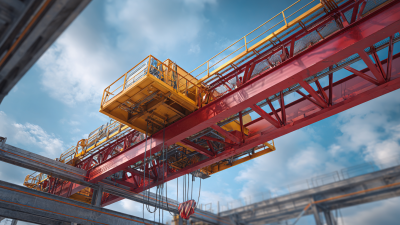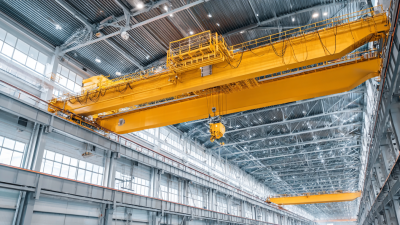Inquiry
Form loading...
-
Phone
-
Wechat

-
Whatsapp

In recent years, the industrial landscape has been evolving rapidly, driven by advancements in technology and a growing emphasis on efficiency. As companies strive to optimize their operations, the demand for specialized equipment such as Eot Cranes (Electric Overhead Traveling Cranes) has surged. According to a report by Allied Market Research, the global crane market is projected to reach $45.36 billion by 2027, with Eot Cranes playing a pivotal role in this growth due to their ability to enhance productivity and safety within various operational contexts.
Eot Cranes are particularly valued for their space-saving designs and ability to streamline heavy lifting processes in manufacturing, construction, and warehousing sectors. A study from Market Research Future indicates that the industrial sector's increasing reliance on automated solutions is further propelling the adoption of Eot Cranes, leading to an expected CAGR of 5.2% over the next five years. As industries continue to prioritize efficiency and automation, Eot Cranes have become indispensable tools, allowing for improved workflow and reduced downtime, ultimately contributing to greater profitability and operational success.
In this context, understanding the top applications and benefits of Eot Cranes is critical for businesses aiming to remain competitive in today’s fast-paced industrial environment. This article will explore the "Top 10" advantages and applications of Eot Cranes, highlighting their essential role in maximizing efficiency across modern industrial settings.

The evolution of EOT (Electric Overhead Traveling) cranes has significantly shaped modern industrial environments, reflecting advancements in technology and the increasing need for efficiency in material handling. Originally designed for the heavy lifting of goods in factories, these cranes have undergone substantial transformations over the decades. Early models were often bulky and operated manually, leading to inefficiencies and increased labor costs. As industries grew and automated processes became prevalent, EOT cranes evolved to feature advanced control systems, enhanced safety measures, and improved load capacities.
Today, modern EOT cranes integrate smart technology such as IoT (Internet of Things) sensors and automated control systems, enabling real-time monitoring and predictive maintenance. This evolution has streamlined operations, reduced downtime, and minimized the risk of accidents. Additionally, contemporary designs emphasize modularity and energy efficiency, allowing manufacturers to tailor cranes to specific operational needs. As industries continue to demand higher productivity and lower operational costs, the role of EOT cranes in facilitating efficient workflows cannot be overstated, marking a pivotal shift towards more sophisticated industrial practices.
Eot cranes, or electric overhead traveling cranes, have become indispensable in contemporary manufacturing environments. Their ability to enhance operational efficiency is evidenced by data from a recent market analysis by Grand View Research, which estimates that the global Eot crane market will reach $5.3 billion by 2028, growing at a CAGR of 4.2% from 2021. This growth is driven by the increasing need for automated solutions in manufacturing processes, where precision and speed are critical.
The key benefits of Eot cranes include improved safety, increased productivity, and reduced labor costs. According to the Occupational Safety and Health Administration (OSHA), workplace accidents can be reduced by up to 30% with the implementation of Eot cranes, primarily due to their advanced load management systems and operational automation features. Additionally, a report by Research and Markets indicates that industries utilizing Eot cranes have reported productivity increases of up to 25%, as these cranes allow for the handling of heavy materials with minimal human intervention, optimizing workflow and minimizing downtime.
In recent years, the demand for EOT (Electric Overhead Traveling) cranes has surged across various industrial sectors due to their unparalleled efficiency and versatility. According to a report by the Global Market Insights, the EOT crane market is projected to grow at a compound annual growth rate (CAGR) of over 5.5% from 2021 to 2027. This growth is driven by the increasing need for automation and lifting solutions in heavy industries such as manufacturing, construction, and shipping. EOT cranes not only enhance productivity but also reduce labor costs, making them an integral part of modern industrial operations.
EOT cranes are employed in diverse applications, fundamentally transforming how industries operate. For instance, the construction sector utilizes these cranes for material handling, significantly speeding up project timelines. A study by Research and Markets highlights that more than 40% of EOT crane installations are in the manufacturing sector, where they facilitate seamless assembly line operations. In the shipping industry, EOT cranes are vital for loading and unloading containers, contributing to faster turnaround times at ports. The versatility of EOT cranes ensures they meet the specific needs of different applications, thereby solidifying their status as indispensable tools in the contemporary industrial landscape.
| Industry | Application | Benefits of EOT Cranes | Efficiency Improvement (%) |
|---|---|---|---|
| Manufacturing | Assembly Line Support | Increased load handling capacity | 25 |
| Construction | Heavy Lifting | Improved safety and speed | 30 |
| Logistics | Warehouse Operations | Maximized storage capabilities | 20 |
| Mining | Material Handling | Enhanced material transport | 35 |
| Energy | Power Plant Operations | Reduced downtime for maintenance | 15 |
The EOT (Electric Overhead Traveling) crane market is witnessing unprecedented growth, driven by a surge in technological innovations that enhance efficiency and safety in industrial applications. According to a recent report by IMARC Group, the global EOT crane market was valued at approximately $5.3 billion in 2022 and is projected to reach $8.1 billion by 2028, growing at a CAGR of around 7% during the forecast period. This expansion is largely attributed to advancements in automation and IoT integration, allowing for real-time monitoring and management of crane operations.
One key technological advancement is the incorporation of smart sensors and data analytics, which significantly improve the operational efficiency of EOT cranes. For instance, predictive maintenance tools can analyze performance data to anticipate failures, thus reducing downtime. A study by Research and Markets indicates that the use of IoT-enabled devices within crane systems can enhance load management by up to 30%, resulting in increased productivity and reduced operational costs. Furthermore, innovations in crane design, such as modular components and lightweight materials, have led to enhanced lifting capacities and improved energy efficiency, making modern EOT cranes an indispensable asset in various industrial sectors.
As industries continue to evolve, the emphasis on sustainable practices has never been more pronounced. EOT cranes play a pivotal role in this transformation, particularly in sectors like the tube and pipe industry, where customized solutions are becoming essential. By optimizing material handling processes, these cranes not only enhance efficiency but also minimize energy consumption, contributing to a greener industrial footprint.
The future of EOT cranes is intertwined with the broader trends in sustainable industrial practices. As organizations strive to reduce waste and improve productivity, the demand for innovative designs and smart technologies in crane systems is on the rise. This shift not only addresses the immediate needs of modern operations but also aligns with the global push towards sustainable resource management. With increasing awareness and the need for eco-friendly solutions, EOT cranes are set to become a cornerstone in achieving operational excellence while supporting environmental goals in various industrial applications.






